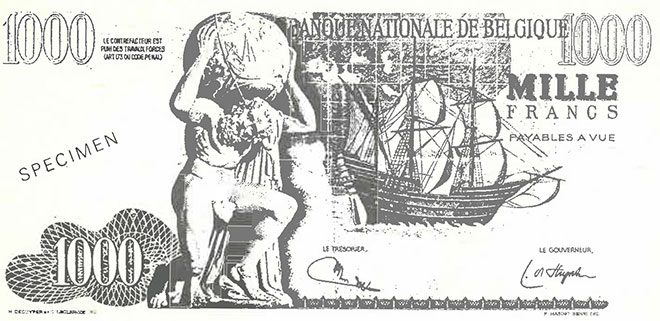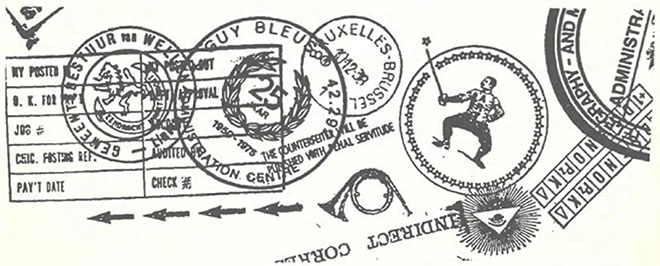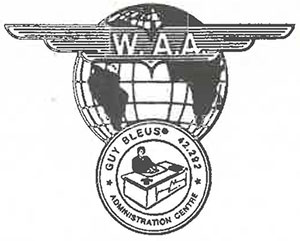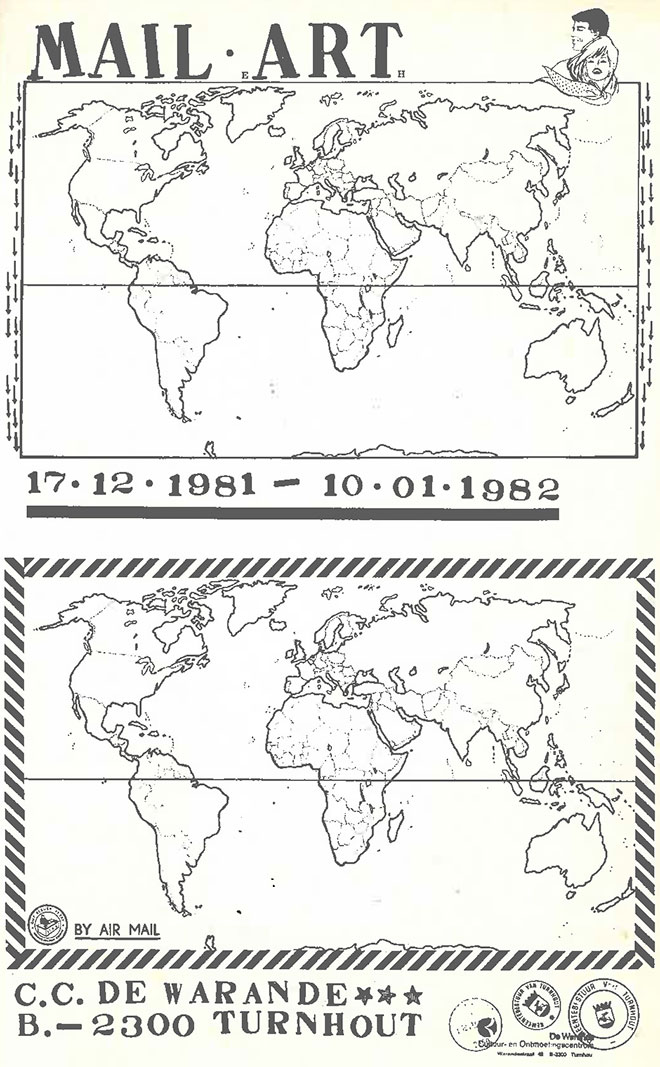Guy Bleus: Mail Art Initiation
Bleus, Guy: Mail Art Initiation, in: Bleus, Guy (ed.): World Art Atlas. MAIL eARTh PROJECT, Vlaamse Gemeenschap, Commissariaat Generaal voor de Internationale Culturele Samenwerking, Turnhout, 1983

It is often suprisingly difficult to say when the history of a specific period or movement starts or to indicate one person that might be representative for its start. The same problems occur with the phenomenon of Mail-Art (M-A).
In 1962 Ray Johnson founds his New York Correspondence School. But at the same time many others Like Arman, Klein, Flynt, Rauschenberg, etc... and the Fluxus group with Ben Vautier, George Brecht, Joseph Beuys, Robert Filliou, Dick Higgins, Nam June Paik, Daniel Spoerri, George Maciunas, ... included stamps, rubber-stamps, writings, letters or postcards in their work.
Although in the beginning of this century there were remarkable events - of Futurism, Dada, Bauhaus, Surrealism, etc. - that made use of the post medium for artistic purposes, it is only since the silver seventies that the innovation and the multiple possibilities of Mail-Art in reference with the postal Service have been I really understood. Since then the term "Mail-Art" has presumably been used for the first time.
What is Mail-Art?
It is a complex matter to define the term "Mail-Art", because it is used with more than one meaning. It refers to a multilateral art form. But it is necessary to know the meaning of the "mail art structure" to understand further denotations.
A. The structure of M-A
includes a new circulation of art. This international network of hundreds of artists does not distribute their works via official galleries, but by post. The M-A structure is "chiefly" based on the international postal service. "ChIefly", because M-A does not necessarily depend on the postal service, e.g. One can send his mail via carrier-pigeons. But the strong administrative postal system wIth its InternatIonal agreements (W.P.U.) is of course the most capable service. It unlocks most remote administrative places in the world.
There is more than one reason why this alternative M-A system started circulating: displeasure with the art policy and the leading galleries, the need to broaden the artistic "function" of the artist, taking part in international projects, publications and exhibitions without a Jury and without making too many concessions. Unfortunately one might blame the new system for favouring the happy few because one has to have the mailing-list at one's disposal to contact its members.
This may be the way to protect the network against corruption (See M-A show).
The whole is more than its parts! "The" M-A network does not exist. There are different small circuits. Every mailing list comprises a circuit. When someone is talking about "the" M-A network. he is talking about all those circuits together. The most lonely circuit is the one-man circuit: someone who sends his mail art to himself, as I sometimes do.
B. The term "Mail-Art" and its relation to the alternative structure.
Posted Art is undoubtedly "Mail(ed)" Art but not necessarily "Mail-Art"! When freedom is a basic principle, it is not easy to indicate any limits. Therefore it is no use to give strict standards to judge wether something might be false or real M-A. Whether a work can be classified under the heading M-A does not only depend on its esthetic qualities, but also - or especially - on the informative, communicative and cultural intentions included in the mailing of the work itself. One may doubt for instance, whether those people who only use the network as a means of publicity consider their "mailed" work as Mail-Art. But the purpose given to a specific work is not always obvious.
Communication by the postal method is therefore a complex matter. The lack of an exact definition of M-A stresses its ambiguous situation: both its strength and its weakness. its strength because of the enormous freedom only limited by the medium "post" or "mailing" (in the widest meaning of the word), its weakness because of the impossibility to identify a work as M-A.
It may therefore be significant to outline a possible - temporarily - classification of M-A.
C. Classification of Mail-Art
1. Mail-Art Network
See above
2. Mail-Art objects
The material used in M-A is not the most important thing. Communication is the main point (being realized by language, signs, materials, ideas, symbols, ...). Almost every object can be medium - vehicle - of communication and be sent by post, the latter being a trans-medium.
A few examples (besides further-mentioned objects) : letters, envelopes, scents, drawings, printed matter, photographs, films, slides, microfilm-counters, notes, stickers, labels, coins, badges, posters etc. All mail artists use (some of) these objects for their communication.
3. M-A Postcards
Can be unique or multiple postcards designed (created) by the M-Artist, e.g. postcard-size collages. Political activities may be stressed (See B. Jesch, KLaus and Rolf Staeck) or personally impressions, conceptual experiences, etc. (E.g. P. Ciani, D.Ciullini, G. Martina, R. (Wolf) Rehfeldt, U. Göbel, T. Ulrichs, K. Groh, J. Olbrich, E. Walsh, Skooter).
4. M-A Paper
The manufacture of art paper (handmade e.a.) for notepaper, books, envelopes, ... E.g. by Tane and Cracker Jack Kid (Chuck Welch). (See 8.)
5. M-A Stamps
Since the beginning of the fifties stamp art has circulated on the scene of artistic action. First it took up a special position, but gradually it has become a M-A activity. One should not confuse art stamps or "treated" postage stamps with the official postal stamps.
W. Kotte divides art stamps as follows:
a. Postal Paintings
These are unica (opposed to multiples), and are a kind of miniature paintings, e.g. Joe Smith, Donald Evans, Dana Atchley.
b. Socially Engaged Stamps
The term goes without saying, e.g. W. Farley, H. Savage, L. Spiegelman, R. Avery, E-A. Vigo.
c. Fluxus and Neo Dadastamps
The stress of these lies on the communicative and conceptual aspect, e.g. K. Friedman, R. Watts, V. Baroni, E.F. Higgins III, D. Boyd, J.W. Felter.
d. Fictitious Stamps
Are alternative, pseudo or plagiarized stamps of the official postage stamps, e.g. Yves Klein and Allen Jones.
e. Ego Stamps
Self-glorification and self-relativity are used interchangeable.
E.g. G.A. Cavellini, P. Below, C. Pittore, L.T. Chew, E.F. Higgins, E. Tot, B. Porter, A. de Araujo.
f. The Largest Group
This refers to stamps on which all previous types (a -> e) are intermingled, possibly provided with other elements, e.g. A. Igloo, D. Drummond-Milne, A. Fallico, R. Maggi, Dogfish, B. Talpo, S. Helmes.
6. (Rubber) Stamp Art:
The design of rubber stamps and/or use and/or recycle of (official) rubber stamps. A combination of (5) and (6) is the rubber stamp in the shape of a postage stamp. Mail artists use rubber stamps and seals applied to different objects or in edited magazines, e.g. Stampedition "Ruimte Z"; Stamp-Art Magazine (Abracadada - W. Gaglione - Dadaland); Stampola (G.Serpa); Rubberstampmadness (J.K. MiLLer and J. Thompson).
Such stamp-magazines are often arranged as follows. Every contributing sends a 100 or 400 (depending on the edition) + identical self-stamped copies to the respective editor(s). Next the latter composes the numbers; that makes a 100 or 400 numbers. The number of pages depending on the number of contributors. The same procedure is sometimes used for other M-A magazines. E.g. Arte Postale!, Bambu, Care. Rubberstamp artists are: G. Brett, J. Van Geluwe, Ko de Jonge, R. Joseph, P. van Dijk, B. Olbrich.

7. Copy Art:
Photo-copy art or "art without an original". An important part of it is xerography or xerox mail art.
Copy art is an instant art form and provides a quick method to get multiples, coloured as well as black and white, but also the potential of copy art cards, enlargements, reductions, degenerations, body art, copy motions, ...
Some copy art magazines: Elektrographics, I.S.C.A., etc.
Artists: e.g. B. Gaglione, B.Cleveland, R. Avery, C. Burch, L. Levine, G. Lloyd, L.F. Dutch, S. Luigetti, A. Banana, L. Odes Neaderland, C. Stetser, E. Morandi.
8. Artists' Books:
Books, made by artists. The book is used as a medium to express oneself, like the canvas for the painter. Bookworks = book objects (the book as an art object), sculptural books, hole books, accordion books, transparent books, braided books, chapbooks (folk books), notebooks, flipbooks, sketchbooks, copy art books, recycling of old books, performance books, concrete books, photograph albums, shade books, marbled books, ...
A multiplicity of techniques exists: (one-of-a-kind and multiple editions) handmade books (scrolled bookworks, (leather) bindings, rubber stamp books, folded bookforms, ...); printed books (self-publishing, prototypes, small editions, small presses, ...) microfiche publications; xerox; photographs; lithography books; etc. Pages made of felt, glass, clay, steel, vinyl, leather, handmade paper, ... The sending of these artists' books has presumably contributed to the development at the mail art network. E.g. G. Ruch, Carl Andre, N. Frangione, B. Danon, M. Bentivoglio, H. Gajewski, R. Huegli, G.A.C., H. Huisman, S. Lewitt, A. Heibel with the group KLAB, SAAB (Swedish Archive of Artists' Books- L. Eriksson). Lectures on artists' books: E.g. J. Hoffberg.
9. Graffiti M-A
AGraffiti
M-A is a contradiction, when we use the term "graffiti" in the meaning of "the art of wall scrawling", "city art" or "mural communication". Graffiti M-A
are photographs of graffiti, scrawls on paper, postcards, letters, envelopes, ... and mailed! Graffiti M-A is studio work.
Some Graffiti Groups are: National Graffiti Artists (founded by J. Pelsinger); Soul Artists; U.G.W. (United Graffiti Writers); Fabulous 5; etc.
Writers: Metallic Avau, Henk Fakkeldij, Ben. T. Ulrichs, M. Wauthoz, ...
Graffiti Magazine: Aerosol (Metallic Avau - V. Wynants).
10. M-A and Semi M-A Magazines
There are lots of different kinds. They may be edited by an artist. Some newsletters may be considered as real M-A magazines - chiefly meant to be informative. Like "Umbrella" (J.A. Hoffberg - Usa). "Arte Postale!" is totally different and somehow related to Undergroundmagazines (See 6.). It is edited by V. Baroni. Also well-known is "Commonpress", based on the concept of P. Petasz. Every number is edited by a different M-Artist and is about a different theme or project (See 17). Others are "Sphinx" (J. Juin - France); "Rubber" (A.V.
Barneveld + C. Goulard - Holland); "Care" (B. Boumans - Holland); "Bambu" CU. Giacommuci - Italy); "Casablanca" (C . Bourseiller - France); "The 80's" (J. Kramer - BRD); "Libellus" (G. + A. Schraenen - Belgium); "Formular Press" (Lomholt - Denmark) "Sema-Cahier" (P. Franzen - Holland); "Eat it up" (T. Patrick - USA); "Original Art Magazine" (G. Bini + L. Grimaldi - Italy); "Collective Farm" (Gerlovins - USA); "Xeropost" (S. Polsky - USA); "K.S.-Magazine" (Jupitter-Larsen - USA); "Art/Life" (J. Cardella + P. Fish - USA); "Correspondence Life" (R. Howard - USA).
11. Poetry M-A - Literature M-A
M-A is not restricted to the field of plastic arts. This form of M-A mainly differs from "traditional" (visual) poetry and literature by the way of distribution. E.g. J. Blaine, G. Criel, E. Minarelli, R. Kostelanetz, R. Summers, P. Simoni, D. Daligand, A. Partum. etc.
Magazines: e.g. "Fetiche Journal" (W.Gaspari); "Dismisura" (G. Fontana); "Anterem" (F. Ermini); "Verticalismo" (S. Commercio); "Theatre du Silence" (G. Guerini - Italy).
12. Audio- and Video Mail-Art
see 11. Audio- and Video-Art play an important part in M-A, e.g. related to audio concepts, sound poetry, poetry, audio drama, performances. Original video- and audio cassettes, singles etc. they are all distributed by post. Audio M-A includes personal (sound cassettes) as well as collective cassettes or artists' records. For audio M-A projects individual sendings are put on one cassette multiplied and distributed. E.g. Trax in Italy and VEC Audio Exchange in Holland, Italy, BRD, USA.
13. M-A (Mail Order) Book Shops:
Mostly specialised in artists' books (See 8), e.g. "Printed Matter" (USA); "Other Books and So On" (Holland); "Art-Metropole" (Canada); etc.
14. M-A Archives and Mailing Lists
A lot of M-Artists have a M-A archive and a mailing list. This is the result of their correspondence with other artists or of the realization of a M-A show, a M-A project or a M-A publication. In a M-A archive mail art means: sorting out, classifying. systematizing, ... Mail-Art is administration!
E.g. Jean Brown Archive (USA); Contart Bureau (DDR); ArtpooL (Hungary); CDO (Italy); Studio 79 (Italy); 42.292 - Administration Centre (Belgium); etc.
15. M-A Lectures - Meetings - Conferences:
Reflections about the essence and meanings of M-A, contemplations about the abuses in the network etc. E.g. L. Spiegelman, R. Crozier, U. Carrión, V. Baroni, Tane. etc. The first international M-A conference has been announced in the "Image Resource Center" in Cleveland (Ohio) from 1st to 10th April 1983 (Org. Harley).
16. M-A Performance:
Performance art with relation to M-A projects. E.g. MIT, Lomholt, Winter, (Aeropus) G. Schraenen, xeroperformances by P. Brusky; etc.
17. M-A Project
This can be a simple theme (e.g. "Administration") or a complex one (e.g . "Mutual Illumination") for a M-A show or a M-A publication. A M-A project is mostly a collective project (e.g. the W. A. Atlas-project with 459 participants from 46 different countries - G.Bleus).
But the project may also be an individual one, e.g. "Scents in the mail" or "Indirect Correspondence" (42.292): by means of a non-existing address one sends a letter - or another postal package - to a person "X" with "X" mentioned as the sender. No direct cooperation of the other artist is needed - only the help of a few postmen and employees. It is almost impossible to get a cassette, magazine or catalogue of a M-A project unless one has taken part in it. This might be a problem for those who only want to have the material because they are interested in it.
But on the other hand they can have the thrilling experience of postal contact with a lot of people.
18. M-A Shows
Exhibitions of M-A objects, postcards, stamps, announcements, ideas, etc., whether or not connected with a certain theme or project. Since some art-collectors or art-dealers try to take advantage of it, the organization of a show must come up to certain conditions, e.g. no jury, no financial contribution (no fees), no return of the entries. Every contribution is exhibited and a catalogue and/or list of the participants is sent to every contributing artist. When an invitation to a M-A show does not come up to these minimal conditions, the artists do not enter into it or (theory) they even summon to boycot the show. The "practical" problem: what to do with the invitations that come up to the conditions and never fulfil them?! (See 15). Maybe this classification has overshot its mark and has caused more confusion. Here you only find an enumeration of a few frequently used methods, terms or media in M-A.
D. Conclusion
I have carefully avoided to give an "absolute" definition of the term "Mail-Art" in order to give it a chance to develop itself.
Anyway, here is an "administrative" definition of M-A:
Mail-Art is a postal wedding of M-A objects, M-A postcards, M-A stamps, rubber-stamp art, copy art, M-A paper, artists' books, M-A magazines, M-A catalogues, poetry M-A, literature M-A, audio- and video M-A, M-A book shops, M-A archives, mailing lists, M-A invitations, M-A lectures, meetings and conferences, graffiti M-A, M-A performances, M-A projects, M-A themes, M-A shows, M-Artists ... and the M-A network.
Though already mentioned (in A.) it might be useful to repeat that M-A cannot be limited to the official postal service. Therefore Marshal MacLuhan's phrase "The medium is the message" might be misunderstood. Letters in bottles, attached to gasballoons or space craft destined for other planets; writing in the air with exhaust fumes of planes; transmission of messages between African tribes by tomtom or telegraphy - these are all different kinds of correspondence used in specified ways. The "specific" use of these media is presumably defined by the way they are applied. This is what gives Mai l-Art its own character.
Also typical for M-A is the easy way to cross borders without difficulty (if the official postal rules are respected and the letter or package does not look or smell dangerous). Criticism is imported and exported, however dictatorial the social system maybe. That is how social criticism can develop itself within M-A. Moreover a dialogue can be started between the followers of the most divergent political views. M-A is not a red, black or blue ideology. It is an international exchange of art, ideas and friendship, a human instrument of communication. But it is no use to romanticize the M-A movement; the response one gets from others is proportionate to the energy and the time one has spent on one s own sending.
Finally, in order to keep a basis for honest barter in ideas and projects, it is very important to exclude anyone who wants to exploit the Mail-Art system. So the movement may go on for years and years. Keep on mailing!
Guy Bleus – 42.292
P.S. This text has already been published in Dutch as the accompagnying prospectus of the M-A show in the Cultural Centre De Warande in Turnhout (B) at the end of 81. It is an "introduction" (therefore incomplete) to Mail-Art. My apologies to:
K. Baik, S. Cho, W. Darnell, G. Deisler, S. Durland, John Evans, K. Kato, D. Maillet, G. Marx, P. Munoz. R. Parmova. M. Spaturu, J. Sunek, A. Yada and
so many others for not mentioning all the names ...


